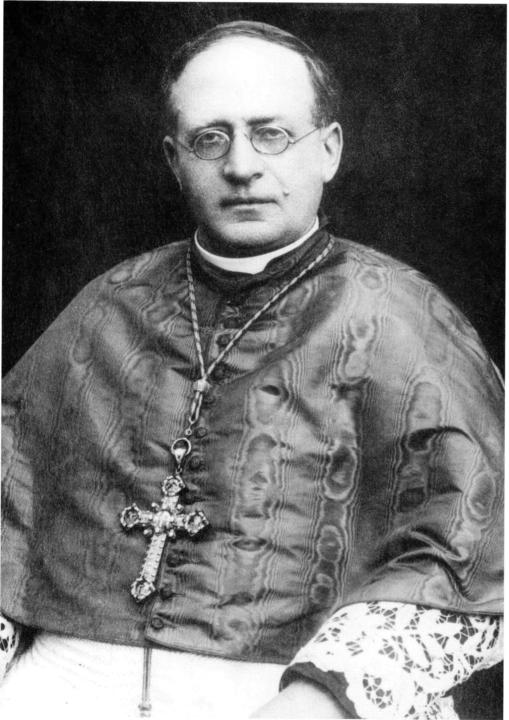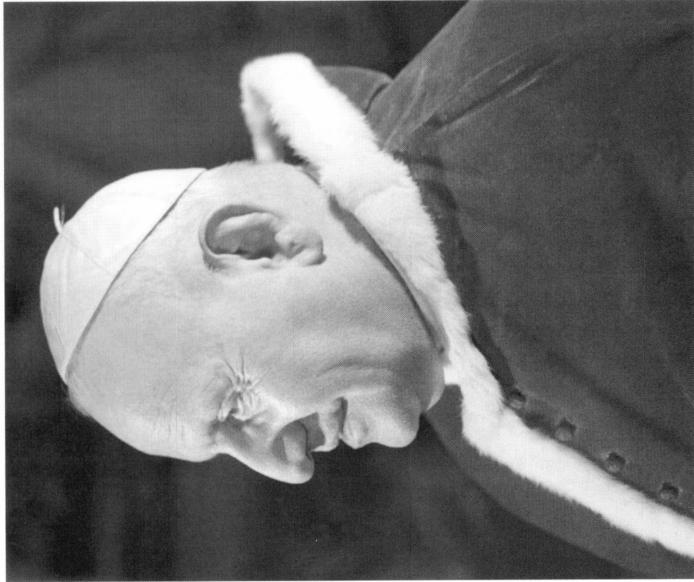The Vatican Exposed: Money, Murder, and the Mafia (22 page)
Read The Vatican Exposed: Money, Murder, and the Mafia Online
Authors: Paul L. Williams

Following the meeting, U.S. officials pursued the prospect of
ordering the indictment of Marcinkus. The bishop, after all, was an
American citizen and subject to American justice. This meant that he
could be extradited to stand trail. Such a measure seemed necessary.
More than $10 million in phony securities were still held by the Vatican, and there existed a strong possibly that even more of the $1 billion order might have been signed, sealed, and delivered.
But the Nixon administration called a halt to the investigation.
The matter was much too delicate and could result in a political backlash by American Catholics.'? It was decided that it was better to forget about the $10 million, the mob, and Marcinkus. After all, the
government couldn't send agents across the Tiber with .45 semiautomatics, search warrants, and handcuffs. "We were not about to
waste that amount of taxpayers' money," William Aronwald later said,
"unless we took the evidence very seriously indeed. At the end of the
investigation the case against Marcinkus had to be filed for lack of
evidence that might have convinced a jury." 18
Therefore everyone who hears these words of mine and
puts them into practice is like a wise man who built his
house on the rock. The rains came down, the streams
rose, and the winds blew and beat against that house;
yet it did not fall, because it had its foundation on the
rock. But everyone who hears these words of mine and
does not put them into practice is like the foolish man
who built his house on sand. The rain came down, the
streams rose, and the winds blew and beat against that
house, and it fell with agreat crash.
Matt. 7:24-27
 s Bishop Paul Marcinkus extolled the banking brilliance of
s Bishop Paul Marcinkus extolled the banking brilliance of
Michele Sindona to the U.S. investigators, the Shark's financial enterprise was beginning to crumble. An elementary rule of
finance says that anyone who steals vast sums of money from a bank will create a gaping hole in the financial institution. As the hole
expands, it cannot be filled with statements of false profits. It must be
plugged with hard cash, revenue to balance the books and regain
some measure of fiscal equilibrium. But when such holes appeared in
his two major banks-Banca Unione and Banca Privata FinanziariaSindona attempted to solve the problem by merging the two firms
into one gigantic firm called Banca Privata. The two large holes
became one massive hole that even the most myopic bank examiner
in Milan could not ignore. By July 1974 Sindona's new bank displayed a loss of 200 billion lire.' Sindona managed to convince the
directors of Banca di Roma to sink $200 million into Banca Privata
in an attempt to fill the troublesome hole. But the tactic didn't work.
The hard cash was not enough to keep the institution from collapsing. By September 1974, less than three months after its creation,
Banca Privata went into compulsory liquidation with losses over
$300 million. The Banca di Roma went into near collapse because of
its ill-advised attempt to come to Sindona's rescue. The Vatican, by
its own admission, lost more than $27 million in the collapse, along
with the amounts it had invested in Banca Unione and Banca Privata
Finanziaria. The loss to Holy Mother Church, by Swiss estimates,
exceeded $240 million.2 Others calculated the losses to be in the
region of $1 billion.3
At the same time a huge hole appeared in Franklin National Bank, a
financial institution that Sindona bought in 1972, as a result of the
Shark's fraudulent removals. The appearance of the hole seemed inexplicable. Franklin National was the eighteenth largest bank in the United
States and one of the healthiest, with assets of $3.3 billion.' But within
two years Sindona managed to empty the coffers of the Long Island institution. The U.S. government, fearing that the collapse of the Long
Island bank could have serious repercussions throughout the country,
provided Sindona with unlimited funds to keep the bank solvent.
Between September and October 1974 over $1 billion flowed from the
Federal Reserve into Franklin. Such efforts proved to be of no avail. On
October 8 Franklin National collapsed, causing losses of over $2 billion
to the Federal Deposit Insurance Company. It was the biggest bank
failure in American history and the first since the Great Depression.
Combing the ashes of the Franklin National, U.S. officials discovered that Sindona had pilfered $45 million from the bank on the
eve of the its demise-an amount that he squandered in his attempts
to manipulate foreign currency speculations and to shore up the
losses in his Italian operations.5
After the collapse of Banca Privata and Franklin National, the
sound of Sindona's falling financial institutions reverberated
throughout Europe. In a matter of weeks Bankhaus Wolff of Hamburg, Bankhaus Herstatt of Cologne, and Amincor Bank of Zurich
lay in financial ruins.6 Uncounted billions fell through a huge
crevice-a crevice that became known in the Italian press as Il Crack
Sindona.
The Italian authorities issued a warrant for Sindona's arrest, and
the Shark fled Switzerland and made off to New York, where he took
up residence at the discreetly elegant Hotel Pierre on Fifth Avenue
and became the "financial consultant" of Johnny Gambino's G & G
(Gambino and Genovese) Company.' Upon advice from David
Kennedy, former secretary of the treasury under President Nixon,
Sindona hired the Richard Nixon/John Mitchell law firm of Mudge,
Rose, Guthrie & Alexander to help in his fight against extradition.8
He also hired a public relations consultant who arranged for Sindona
to deliver lectures at leading American universities.
At the University of Pennsylvania, Sindona waved the American
flag and spoke as an economic idealist. He began his address by
saying: "The aim, perhaps an ambitious one, of this brief talk is to
contribute to restoring the faith of the United States in its economic,
financial, and monetary sectors, and to remind it that the free world
needs America."9
At Columbia University, several days after he was sentenced in
absentia by a Milan court to three and a half years in prison for
embezzlement, Sindona upheld the importance of high morals and
fiscal accountability by saying: "When payments are made with the
intent of evading the law in order to obtain unfair benefits, a public
reaction is clearly called for. Both the corrupted and the corrupter
should be punished."10
The appearances of Sindona at such prestigious institutions seemed to be ripped out of the pages of Mad magazine. The financial capo of the Sicilian Mafia was lecturing ivy-league students-the
future business leaders of America-on business ethics, financial
strategies, and the creation of idyllic "cosmo-corporations."
In September 1975, when photos of Sindona being greeted by
New York Mayor Abraham Beame appeared in the international
press, cries of outrage could be heard throughout Italy. The Italian
newspaper Corriere della Sera fumed: "Sindona continues to release
statements and interviews and continues, in his American exilerefuge, to frequent the jet-set. The laws and mechanisms of extradition are not equal for all. Someone who steals apples can languish in
prison for months, perhaps years. An emigrant working abroad who
does not reply to his draft board is forced to come back and face the
rigors of the military tribunal. For them, the twists and turns of the
bureaucracy do not exist."
In the United States, Sindona remained impervious to such wails
and laments. Johnny Gambino, and other New York mafiosi, treated
Sindona as an uomo rispettato (dear person). They called him Don
Michele and held banquets in his honor. Nino Gambino, Johnny's
son, later recalled that members of the crime family constantly sought
out Sindona and exclaimed: "Don Michele, you are the greatest of all
Sicilians. We are proud of you. Let us help you with your problems.
Tell us who you want killed. Tell us who these bastards are. We will
do this for you because we respect you. No money, Don Michele. We
murder only for our friends."II
Sindona may have provided such a list because five of the Italian
investigators who probed into the affairs of "the pope's banker"
(including the Bank of Italy's attorney Giorgio Ambrosali) became
victims of mob-style assassinations.12 Others who ventured to testify
against "Don Michele" met a similar fate. Gratiziano Verzotto, the
former regional secretary of the Christian Democracy Party, was
gunned down in Palermo after talking to authorities about bribes he
had received from Sindona. Verzotto managed to survive, but he got
the message and fled to Beirut.'3 Others, including Giuseppe Di
Cristina, who knew the intricacies of Sindona's connection with the
flow of heroin throughout the Western world, were not so lucky. Di Cristina was murdered on a street in Palermo. On his body police discovered checks that had been drawn from Swiss banks that had been
controlled by Sindona.14

Achille Ratti, Pope Pius XI. (Photo from Catholic News Service.)
